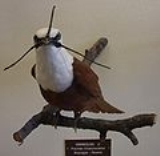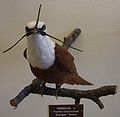
Three-wattled bellbird
Encyclopedia
The Three-wattled Bellbird (Procnias tricarunculata) is a Central America
n migratory bird
of the cotinga
family.
, the Three-wattled Bellbird is between 25 cm (9.8 in) and 30 cm (11.8 in) long. The body, tail, and wings of the male are uniformly chestnut-brown; its head, neck, and upper breast are white; and it has a black eye-ring, eye-stripe, and bill. Its name comes from the three worm-like wattles of skin that hang from the base of the bill. These wattles can be as long as 10 cm (3.9 in) when extended during songs and interactions. The wattles remain flaccid even when extended. The male shakes the wattles, but otherwise they hang straight down; they are neither erectile nor under muscular control. The side wattles do not stick out to the sides and the central one is not extended directly skywards as shown on some old illustrations and specimen
s. The female bellbirds are smaller and less striking in appearance, being overall olive with yellowish streaking below, pure yellow vent and no wattles.
Famous for having one of the most unusual and distinct vocalizations of any bird in its range, the three-wattled bellbird exists from western Honduras
south to eastern Panama
. While little is known about the migratory behavior of these birds, they breed primarily in Costa Rica
n highlands (March-September) and return to lower elevations for the interim months.
 Because of the secretive behavior of this bird, it is often only detected by the distinctive bell-like call given by the males. At close range, the vocalization of many in Costa Rica is heard as a complex three-part song, the "bonk" giving the bird its name. This hollow, wooden "bonk" is thought to be among the loudest bird calls on Earth, audible to humans from over 0.5 mi (0.80467 km) away. The song is different in Nicaragua and in also Panama, and these songs also include an extremely loud, but less bell-like, note.
Because of the secretive behavior of this bird, it is often only detected by the distinctive bell-like call given by the males. At close range, the vocalization of many in Costa Rica is heard as a complex three-part song, the "bonk" giving the bird its name. This hollow, wooden "bonk" is thought to be among the loudest bird calls on Earth, audible to humans from over 0.5 mi (0.80467 km) away. The song is different in Nicaragua and in also Panama, and these songs also include an extremely loud, but less bell-like, note.
Research by Donald Kroodsma on recordings archived at the Cornell Lab of Ornithology showed that the Three-wattled Bellbird is unique among members of its sub-order, in that it learns its song, rather than having the song determined by instinct, because the song changed over the years that it had been recorded.
Central America
Central America is the central geographic region of the Americas. It is the southernmost, isthmian portion of the North American continent, which connects with South America on the southeast. When considered part of the unified continental model, it is considered a subcontinent...
n migratory bird
Bird migration
Bird migration is the regular seasonal journey undertaken by many species of birds. Bird movements include those made in response to changes in food availability, habitat or weather. Sometimes, journeys are not termed "true migration" because they are irregular or in only one direction...
of the cotinga
Cotinga
The cotingas are a large family of passerine bird species found in Central America and tropical South America. Cotingas are birds of forests or forest edges, which mostly eat fruit or insects and fruit. Comparatively little is known about this diverse group, although all have broad bills with...
family.
Overview
One of four species of bellbird that live in Central and South AmericaSouth America
South America is a continent situated in the Western Hemisphere, mostly in the Southern Hemisphere, with a relatively small portion in the Northern Hemisphere. The continent is also considered a subcontinent of the Americas. It is bordered on the west by the Pacific Ocean and on the north and east...
, the Three-wattled Bellbird is between 25 cm (9.8 in) and 30 cm (11.8 in) long. The body, tail, and wings of the male are uniformly chestnut-brown; its head, neck, and upper breast are white; and it has a black eye-ring, eye-stripe, and bill. Its name comes from the three worm-like wattles of skin that hang from the base of the bill. These wattles can be as long as 10 cm (3.9 in) when extended during songs and interactions. The wattles remain flaccid even when extended. The male shakes the wattles, but otherwise they hang straight down; they are neither erectile nor under muscular control. The side wattles do not stick out to the sides and the central one is not extended directly skywards as shown on some old illustrations and specimen
Specimen
A specimen is a portion/quantity of material for use in testing, examination, or study.BiologyA laboratory specimen is an individual animal, part of an animal, a plant, part of a plant, or a microorganism, used as a representative to study the properties of the whole population of that species or...
s. The female bellbirds are smaller and less striking in appearance, being overall olive with yellowish streaking below, pure yellow vent and no wattles.
Famous for having one of the most unusual and distinct vocalizations of any bird in its range, the three-wattled bellbird exists from western Honduras
Honduras
Honduras is a republic in Central America. It was previously known as Spanish Honduras to differentiate it from British Honduras, which became the modern-day state of Belize...
south to eastern Panama
Panama
Panama , officially the Republic of Panama , is the southernmost country of Central America. Situated on the isthmus connecting North and South America, it is bordered by Costa Rica to the northwest, Colombia to the southeast, the Caribbean Sea to the north and the Pacific Ocean to the south. The...
. While little is known about the migratory behavior of these birds, they breed primarily in Costa Rica
Costa Rica
Costa Rica , officially the Republic of Costa Rica is a multilingual, multiethnic and multicultural country in Central America, bordered by Nicaragua to the north, Panama to the southeast, the Pacific Ocean to the west and the Caribbean Sea to the east....
n highlands (March-September) and return to lower elevations for the interim months.
Song

Research by Donald Kroodsma on recordings archived at the Cornell Lab of Ornithology showed that the Three-wattled Bellbird is unique among members of its sub-order, in that it learns its song, rather than having the song determined by instinct, because the song changed over the years that it had been recorded.
External links
Further reading
- Snow, D.W. (1982). The Cotingas: Bellbirds, Umbrella birds and their allies. British Museum Press. ISBN 0-19-858511-X

